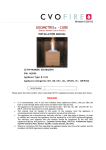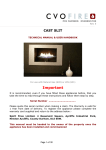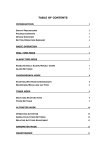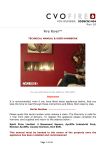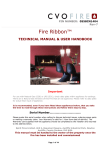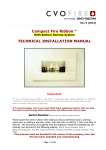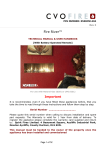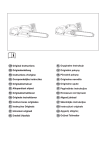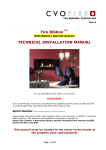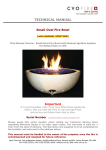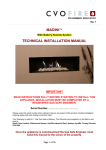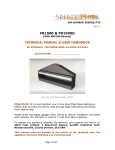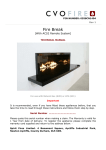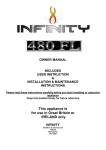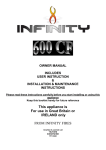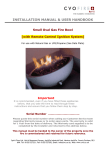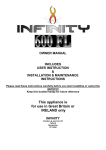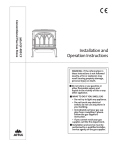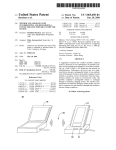Download Fire Wave - CVO Fire
Transcript
CE PIN NUMBER: 0063BT5051 Revision-7 [2011] Fire Wave INSTALLATION MANUAL Serial Number Please quote this serial number when contacting CVO Fire. Important • • • • • • It is recommended, even if you have installed these appliances before, that you take the time to read through these instructions and follow them step by step. The appliance is CE approved for use with Natural Gas – I2H, I2E, 2E+, I2L and LPG I3P, I3+, I3B/P. Check the data plate for actual appliance setting. This manual must be handed to the owner of the property once the appliance is commissioned and retained onsite for operation and servicing reference. The appliance has a manufacturer’s warranty valid for 1 year from date of delivery. In order to validate the warranty the appliance must be installed by a GAS SAFE Engineer. The warranty card supplied with this booklet should be completed by the GAS SAFE Engineer and posted to : Customer Service Dept, CVO Fire. 4 Beaumont Square, Aycliffe Industrial Park, Newton Aycliffe. County Durham. DL5 6XN. Whenever contacting CVO Fire regarding the appliance please have the serial number and the installers GAS SAFE registration number available. Page 1 of 42 Contents 1 Appliance Technical Data 2 Appliance General Information 3 Warning for Fire Guards and Hearths 4 Appliance Unpacking Instructions 5 Remote Control System 6 Appliance Installation Instructions 7 Appliance Commissioning Instructions 8 Appliance Start Up / Shut Down Instructions 9a Appliance Fault Diagnosis Instructions 9b Battery Remote System – Fault Diagnosis 9c Battery Remote System - Schematic 10 Appliance Cleaning Instructions 11 Appliance Servicing Instructions 12 Appliance Spare Parts 13 Appliance Warranty 14 Fitting The Optional Wall Switch 15 Converting The Fire To Mains Supply 16 Contact Details 17 User Manual Every appliance has been designed, manufactured and type tested to ensure that it conforms to the current national and European DFE (decorative fuel effect gas fire) legislation. If you have any queries regarding these instructions or require additional technical support or advice on the installation of our products, please contact our technical support team on 01325 327 221. Every fire is bubble tested to 150mBar, flow rated and given a 100% function test. This ensures that all CVO Fires work fully when leaving the factory. When installed Page 2 of 42 inline with the instructions in this manual the owner will enjoy many years of enjoyment from the fireplace. Please take time to read the instructions fully. The installer is to advise the user not to stand too close to the appliance for prolonged periods of time and that loose clothing is particularly at risk of burning due to the presence of an unguarded flame. 1. Appliance Technical Data 1.1. General Specification Oxypilot Assembly Marking Gas Connection Size Minimum Flue Diameter (Millimetres) Minimum Flue Height (metres) Appliance Mass (kilograms) 9 IT 9 IE 9 HU HR FI 9 GR ES 9 GB EE 9 FR DK DE 9 9 9 9 9 9 9 9 9 9 9 9 9 9 9 9 9 9 9 9 9 9 9 9 9 9 9 9 9 9 9 9 9 9 Countries of Destination SE Sl SK TR 9 9 RO 9 9 PT PL 9 NO NL 9 MT LPG 9 9 LV NG CZ Gas Type 9 LU LPG I2H - G20 at 20mbar I2E - G20 at 20mbar I2L - G25 at 25mbar I3P - G31 at 37mbar I3+ - G30'G31 at 28-30'37mbar I3B/P – G30'G31 at 30mbar CY NG Gas Category, Type And Supply Pressure 9 LT Gas Type 9 CH LPG I2H - G20 at 20mbar I2E - G20 at 20mbar I2E+ - G20'G25at20'25mbar I3P - G31 at 37mbar I3+ - G30'G31 at 28-30'37mbar I3B/P – G30'G31 at 30mbar Countries of Destination BE NG Gas Category, Type And Supply Pressure AT Gas Type Natural Gas Burner : NG9103 , LPG9272 8.0mm O.D. tubing 250.0 3.0 50.0 9 9 9 9 9 9 9 9 9 9 Injector (1 per appliance) Gas Category, Type And Supply Pressure Marking I2H - G20 at 20mbar I2E - G20 at 20mbar I2E+ - G20'G25at20'25mbar I2L - G25at 25mbar I3P - G31 at 37mbar I3+ - G30'G31 at 28-30'37mbar I3B/P – G30'G31 at 30mbar 9 9 9 9 9 9 9 9 9 9 9 Nominal Heat Input kW, Gross 13.3 460 13.3 13.3/12.3 12.3 13.8 135 13.8 13.8 Page 3 of 42 9 9 2. Appliance General Information The appliance is intended for decorative purposes only. The chimney should be swept before the appliance is installed, and should be swept and inspected regularly to ensure that all products of combustion are entering the flue and there is no excessive build up of soot. Foreign objects should not be placed on to the appliance or otherwise disturb the fuel bed. Debris from any source, or soot formed, should be removed from the appliance, see ‘Appliance Cleaning Instructions’. The appliance may emit a slight smell for a period of time after commissioning. This is quite normal and any odours will disperse within a few hours of operation. The pilot light and flame sensing device installed to the appliance are also atmospheric sensing devices. The device is not adjustable and must not be disabled. If evacuation of combustible products is interrupted the device shuts down both the main burner and pilot light. In the event of a single shut down, do not attempt to re-light the pilot within three minutes, once three minutes have passed the appliance can be re-started in accordance with ‘Appliance Start Up / Shut Down Instructions’. In the event of repeated shut downs, do not use the appliance and have the flue and appliance checked by a GAS SAFE Engineer. If any part of the pilot assembly needs to be replaced, including the pilot burner, thermocouple, electrode and injector the complete assembly must be replaced with an original manufacturer's pilot assembly by a GAS SAFE Engineer. Warning – Do not adjust the system. Warning – Do not disable the flame sensing device. Warning – Use only OEM parts. The installation should only be carried out by a GAS SAFE Engineer and in accordance with national and local regulations for gas. The installation must also be in accordance with relevant parts of local and national building regulations. For the Republic of Ireland, reference should be made to IS813 and ICP3 and any guidance notes from Bord Gais. Read the instructions carefully before proceeding. Failure to do so could result in an unsafe installation and may invalidate the warranty. 3. Warning for Fire Guards and Hearths The appliance is not installed with an integral guard. In normal use consideration may be given to the use of a fireguard conforming to BS6539 or BS6778, so that the approach to the appliance is limited such that access to the flame is minimised. It is recommended that a fireguard conforming to the requirements of BS6539 or BS6778 be installed if the appliance is used in the presence of young children, the elderly or the infirm. For some countries a noncombustible hearth must be installed in front of the appliance in accordance with national regulations (e.g. United Kingdom). In addition, the installer is to advise the user against placing combustible material directly in front of the appliance. 4. Appliance Unpacking Instructions Carefully examine the carton for damage before unpacking. If the appliance is damaged in anyway DO NOT INSTALL. Contact 01325-327221. Once installation has begun it is accepted that the fire was in perfect condition. Remove the appliance and examine its general condition. If satisfied by the condition of the product, proceed with the installation. Page 4 of 42 5. Remote Control System Take some time to learn about the remote system fitted to this fire. Review the circuit diagram to familiarise yourself with the system components. This gas fire is operated by a remote control system which is powered by “AA” batteries. The fire is supplied with a remote hand set which will switch the fire on/off and regulate the flame up/down. There are options available to add a manual wall switch and to convert to mains power supply. Handset: In order to operate the appliance the handset must be pointed directly at the magic eye (line of sight) on the fire. The hand set has a child safe feature to avoid accidental lighting. Please read “lighting the fire” section later in this handbook before operating the appliance. The remote is powered by 6 x ‘AA’ Batteries in the appliance and a 9V battery in the handset. It is recommended that only “Lithium” batteries are used in the remote system to ensure a long life. Note: that if the fire shuts down it is automatically set in “safe mode” to reactivate the fire press button #1 only on the handset. This will cause a beep. Now the fire can be lit again using the standard start-up sequence. The remote system has a fault diagnosis system built in which is indicated by a number of beeps. Review the “fault diagnosis” section later in this manual for the code. A warning sound when the internal batteries become low will e heard however if the batteries are totally dead there will be no sound. If the appliance fails to operate on the hand set change the batteries in both the appliance and the hand set as this is the most common cause of failure. IMPORTANT NOTE: All CVO fires are given a 100% full function test at the factory before being shipped. Never remove the heat shield or any wires from the black box or the remote system. All connections are required. There is no need to remove any connections from the remote system during installation. Removal of any connections will result in the warranty being invalidated and no claims will be accepted for the unit not working. Page 5 of 42 6. Appliance Installation Instructions (To be carried out by a Registered GAS SAFE Engineer only – failure to comply with this requirement will invalidate the Warranty) 6.1. General GATHER: This appliance is fitted with a gather unit which must be remaining attached to the appliance. Removal of the gather will render the appliance dangerous. The gather must be sealed with high temperature silicone fire cement. FLUE: The minimum flue requirement is 3 metres of 250mm diameter. Usage with any smaller flue will render the appliance highly dangerous. Clearances between the appliance and all combustible materials must conform to national regulations. The appliance must be installed and used in accordance with these instructions. Prior to installation, ensure that the local distribution conditions (identification of the type of gas and pressure and the adjustment of the appliance) are compatible. The builders opening or fireplace opening must be constructed of a non-combustible material. Any flue damper plate or flue restrictor must be removed or fixed permanently in a fully open position, or shall only be installed in accordance with national regulations. The chimney must be swept before the appliance is installed. If the chimney is not swept, there is a possibility that loose debris may fall onto the burner unit which may result in damage and unnecessary service costs. Before the appliance is installed a flue test in accordance with national regulations should be carried out. The appliance must not be installed unless the chimney or flue length is at least the length and size indicated in the section marked ‘Appliance Technical Data’ earlier in this manual. Under no circumstances should the appliance be installed and operated within any premises without an adequate flue or chimney system. A room ventilation air supply must be installed in accordance with national regulations and should be checked regularly to ensure that it is free from obstruction. Soundness of the input gas line should be checked prior to installing the appliance. The gas connection must be made in accordance with national regulations. An isolation valve (stop tap) must be installed adjacent to the appliance, which when closed allows the complete burner and control assemblies to be disconnected for maintenance and repair in accordance with national regulations. Adjustment of the pilot assembly is not usually required, however during installation the assembly may become misaligned. The gap between the pilot electrode and the pilot should be 3.5 – 4.5mm allowing the spark to bridge the gap between the electrode and the gas outlet on the pilot head, at the point where gas is ejected. Page 6 of 42 6.2 Burner Ventilation Requirements This fire is designed to be used as a “trimless” fire. For the fire to work correctly additional burner ventilation must be planned to provide fresh air into the burner box. This work should be planned before starting to install the fire. This additional burner air must be routed from “within the room the fire is installed” directly in to the burner box. Failure to observe this will result in serious heat damage to the remote system. This will not be covered by the warranty. The normal way to do this is by creating a ducted space behind the plasterboard from the skirting level. The air vent must be at least 20mm deep and the full width of the burner flame. If it is positioned differently the flame will become unstable. The system must be sealed so that air can only travel in one direction from the room into the burner box and cannot travel up the back of the enclosure. If the air is not sealed flame reversal will occur. See the images below SIDE VIEW FRONT VIEW Page 7 of 42 6.3 Appliance Installation Before commencement of any building works we recommend that a thorough structural survey is carried out of the installation location, ensuring that any work done will be safe. A flat, level, opening must be prepared in accordance with local building regulations to the following specification:- The Fire Wave is supplied as a complete unit with built in remote and gather unit. There should be no reason to dismantle the appliance. The only connection required is an 8mm gas supply. The Fire Wave does not have its own support lintel. Therefore in some cases it may be necessary to install a lintel above the opening. Check with building regulations if in doubt. This Fire is supplied with the gather unit attached. This is required in order to ensure the fire operates safely and inline with the CE approval. The enclosure is then inserted into the opening and positioned so that the front edge is aligned with the final face of the wall. Please note that if a wall cover (plaster board) is to be added this must be taken into account. A suitable gas supply is required within the opening. The appliance is supplied with an isolation ball valve. This should be retained and used as the connection point. The complete unit is inserted into the building opening and the gas supply fed into the burner tray via one of the holes provided. All other holes must be blocked with a suitable metal tape. Great care must be taken when handling the fire burner to ensure the battery remote system does not become damaged. Any gaps between the enclosure, gather and flue system should be sealed with fire cement to ensure a closed system. Page 8 of 42 6.4 Gas Supply GAS FLOW RATES: NATURAL GAS 1.6m3/Hour LPG/PROPANE 0.6m3/Hour This is a high power [14KW] appliance and needs a very strong and constant gas supply. Before installing this appliance the gas pipe work needs to be reviewed to ensure the gas pressure at the appliance, when on full, remains at 20mBar at all times. If the appliance is run with a gas supply which is not suitable it will render the appliance unreliable and possibly dangerous. Once the fire is connected, the gas must be tested “at the test point within the fireplace enclosure” as per the commissioning sequence: 1. Other appliances in the house off. a. Standing Pressure – Off b. Inlet Pressure – On Pilot c. Inlet Pressure – On Full 2. Other appliances in the house on. a. Standing Pressure – Off b. Inlet Pressure – On Pilot c. Inlet Pressure – On Full 3. The pressure must remain at +/- 1mBar of the value stated on the dataplate. SEE IMAGE ON PAGE 11 Page 9 of 42 6.4 Final Checks before lighting the fire. NOTE – REMOTE SYSTEM The appliance is operated by 6 x “AA” batteries. It is advised that Lithium batteries are used to increase life. The fire is supplied with a Handset and a Magic Eye. There is the option to add a Manual Wall Switch. This must be fitted during installation. If this has not been ordered then call 01325-327221 and request the part. NOTE – APPLIANCE SEALED TO CHIMNEY CAVITY. The enclosure must be sealed to the fireplace opening to create a closed system which only allows air to be drawn from the room by the chimney. Take special care to ensure there are no openings below the fireplace box where air can be drawn down the back side of the enclosure and from the burner tray. The Gather must be used. NOTE – BURNER TRAY HOLES The appliance is supplied with additional holes in the burner tray to allow gas pipe access from various points. Once the gas pipe is fitted all other burner access points must be covered using aluminium tape. Failure to do this may result in incorrect flame activity and damage to the remote system. Any resulting damage caused by incorrect installation is not covered by the warranty. GAS LEAKS With the isolation valve in the appliance switched off, test the gas line from the meter to the appliance to ensure there are no gas leaks in the system. The appliance is bubble tested at 150mBar before leaving the factory. ROOM VENTILATION The room must have an air vent in the room to provide a minimum of 100cm2 fresh air from the outside? BURNER VENTILATION Has the fire been designed with burner air provided? See page 7. NOTE - USING LPG BOTTLES This is a high power fire and uses a high volume of gas. In very cold conditions LPG can take longer to vent into gas and this may cause a drop in pressure which will shut the appliance down. If this appliance is to be connected to LPG bottles it is recommended that 2 x 47Kg bottles with a changeover valve is used. This must also include a regulator. WARNING: HEAT SHIELD. IF THIS APPLIANCE IS OPERATED WITHOUT THE REMOTE HEAT SHIELD IN PLACE AND SECURLY FITTED TO THE BURNER TRAY SERIOUS DAMAGE WILL OCCUR TO THE REMOTE CONTROL SYSTEM. ANY RESULTING DAMAGE WILL NOT BE COVERED BY CVO FIRE AND IS NOT COVERED BY THE WARRANTY. Page 10 of 42 7. Appliance Commissioning Instructions The burner inlet flow rates are factory set and sealed. Under no circumstances should these settings be changed. The aeration is fixed. Do not change the burner aeration. Step 1: The appliance is supplied with a pressure test elbow and gas tap. Connect an 8mm gas supply to the tap and test for leaks. Remove the screw from the test point within the appliance and connect a manometer. Step 2: The appliance requires 6 x “AA” Lithium batteries to operate. Using lower quality batteries is not advised. The Battery Pack is disconnected when supplied to increase the life of the batteries. Reconnect the battery by plugging in the socket. Step 3: The appliance is supplied with an Infra-Red Remote Control Unit which is operated via a hand set and magic eye positioned on the right hand side of the enclosure. There is also a manual wall switch. Step 4: Light the appliance as shown in section 7. Once lit turn the appliance onto the full setting and read the gas pressure from the manometer attached to the inlet test point elbow – WITHIN THE APPLIANCE. Step 5: It is very important that this test is performed as stated to ensure the appliance is safe and reliable. The inlet supply pressure must be within (+/- 1mb) of the pressure stated on the Data Plate. For example a 20mBar NG appliance must read between 19mbar and 21mBar. Light all other gas appliances in the house, including central heating systems and check the inlet pressure again. The pressure must still be within the tolerance of +/- 1mb. Now turn off all the other gas appliances and turn the appliance down to pilot only, the pressure must still be in the tolerance of +/- 1mb. These 3 tests will ensure the fireplace is safe. Page 11 of 42 Step 6: IF FAILED: If it is not possible to maintain the pressure at the required level, TRANSCO, BORD GAIS or the propane supplier must be called to adjust the governor to the house before the appliance can be commissioned further. Step 7: IF PASSED: Disconnect the pressure gauge, replace the pressure test point sealing screw and test the appliance for gas soundness. Insert the front shelf. Step 8: Turn the appliance to the maximum setting. Leave the appliance for 10 minutes and then test that all the products of combustion are entering the flue by traversing the perimeter of the fireplace opening or canopy using a smoke generator e.g. smoke matches. Step 9: The customer should be shown in detail how to operate the appliance and the installation and user manual given to the customer. The customer must also be made aware that the appliance must be serviced every 12 months and that chimney or flue system should be checked regularly to ensure the appliance operates at optimum performance. Step 10: The warranty card is to be completed by the registered engineer who has commissioned the appliance. This is to validate the warranty. The card must then be given to the customer for return to the factory. If you have any questions, or the appliance is not operating correctly, please consult the fault diagnosis chart and then contact the CVO Fire technical team BEFORE you leave the installation. As part of our customer service procedure you will be asked for the appliance serial number on the front cover of this booklet and the GAS SAFE registration number of the Engineer. If the appliance is not installed in strict accordance with these instructions CVO Fire cannot be held responsible for any damage caused and reserve the right to charge for any corrective work. The warranty covers defective components or manufacture not incorrect installation or site specific conditions. Page 12 of 42 8. Appliance Start Up / Shut Down Instructions The appliance requires 6 x AA Lithium batteries to operate. The handset has a 9v battery. If the main burner or pilot light is extinguished during lighting, do not attempt to relight the pilot within three minutes. There are two methods of lighting the appliance – Hand Set (Infra Red) and Manual Wall Switch (this is an optional extra – to order call 01325-327221) 8.1 Using the Remote Control Handset (see image) The handset requires “line of site” to a maximum of 3 metres. If the handset is not pointed directly at the magic eye the fire will not operate. If the handset fails to operate it may require new batteries. The handset must be handled with care. If it is dropped it will be damaged. Page 13 of 42 • TO TURN APPLIANCE “ON” o Press Button #1 & #2 at the same time and point directly at the magic eye. The buttons must be held for 3-5 seconds. This is a child safe system to stop accidental lighting. The ignition sequence will start. The gas to the pilot is opened and the magnet unit pressed by the motor, the spark is generated. When the pilot flame presence is detected (ionization flame control) the system holds for 10 seconds to warm the thermocouple. o Once the thermocouple is warm enough to hold the magnet unit the valve will allow gas to the burner at the maximum setting. o In case of failure during pilot ignition sequence, the EDB puts the system in safe mode. To restart the ignition sequence press Button #1 again. • STANDBY MODE o It is possible once the fire is lit to operate in standby mode with pilot only lit. To do this press button #2. • HIGH / LOW FLAME o By pressing Button #3 (increase) or Button #4 (decrease) the power output of the appliance can be set between maximum and minimum levels. o By pressing Button #3 the burner flame is increased to the maximum rate. o By pressing Button #4 the burner flame can be reduced to the minimum rate. • TO TURN APPLIANCE “OFF” o To turn the appliance OFF Button #1 is pressed. • Each time a button is pressed a “beep” will be heard. • To Summarise: o Button #1 & #2 together – This switches the appliance ON. • o Button #1 – This switches the appliance OFF. o Button #2 – This sets the unit into standby mode (pilot only) o Button #3 – This sets the flame at maximum rate. o Button #4 – This sets the flame at minimum rate. Each time a button is pressed a “beep” will be heard. Page 14 of 42 8.2 Using the Manual Control Panel. [if fitted] When fitting please ensure the cable does not become detached from the membrane. The membrane has a self adhesive pad which can be stuck to the wall. • Button #1 - By pressing this switch, this starts the ignition sequence (press & hold for 3 sec minimum). The gas to the pilot is open and the magnet unit pressed by the motor, the spark is generated. When the pilot flame presence is detected the system holds for 10 seconds to warm the thermocouple. • Once the thermocouple is warm enough to hold the magnet unit the valve will allow gas to the burner at the maximum setting. • In case of failure during pilot ignition sequence, the EDB puts the system in safe mode. To restart the ignition sequence press Button #1 again. • It is possible once the fire is lit to operate in standby mode with pilot only lit. To do this press button #2. • By pressing Button #3 the burner flame is increased to the maximum rate. • By pressing Button #4 the burner flame can be reduced to the minimum rate. This may involve pressing the switch a number of times in steps to get the lowest setting. • To turn the appliance OFF Button #1 is pressed. • Each time a button is pressed a “beep” will be heard. If the appliance is shut down unexpectedly the valve must be reset first before the fire can be re-lit. To do this press the “OFF” button until a beep is heard. Then commence the starting sequence as detailed above by pressing both left had buttons at the same time. The pilot is a safety device which monitors the gas pressure and flue conditions. If a fault in either of these areas are detected the pilot will not allow the fire to be lit. Please review the installation conditions before proceeding. Page 15 of 42 8.3 How to Shutdown the appliance if the appliance is lit and both the Handset and Wall Switch are Faulty. The appliance has a safety shut down switch which is built into the remote system. This is in the form of a button fitted inside the appliance. In the unlikely event that the handset is lost, damaged or broken and the manual wall switch is broken while the fire is lit the fire can be shutdown by pressing this button. Safety Shutdown Procedure • • • • • • • • Carefully lift the front shelf taking care that the appliance will be hot. The reset button is fitted to the top of the remote shield. Carefully insert hand below the shelf taking care not to touch any hot surfaces. Press and hold the button for up to 60 seconds and the appliance will shut down. Taking care not to touch any hot surfaces, carefully remove your hand and replace the front shelf. Do not use the appliance until the remote handset and wall switch have been repaired or replaced. To purchase a new handset call 01325-327221 If the fire has been converted to mains then the reset button will be replaced by the mains adaptor socket. In this instance unplug the adaptor from the socket and the fire will shut down. Page 16 of 42 9. Appliance Fault Diagnosis Instructions All CVO Fire appliances are bubble tested to 150mBar to ensure there are o gas leaks, they are then given a full function test for over 1 hour to ensure all functions and safety devices are inline with the CE approval. It is highly unlikely, that if the appliance has been installed correctly as set out in this manual that the appliance will not function. Please use the fault diagnosis tick sheets to resolve any issues which may arise during installation. 9.a. General Symptom Check List The system “beeps” all the time. There is a fault diagnosis system built into the battery remote. The remote gives out a sequence of “beeps”. This is a code which indicates a fault. See section 13 for details. Appliance clicks but no spark or weak spark. Check spark lead is connected properly. Check spark electrode is in the correct area and the gap correctly distanced to the pilot. See image. Check for a good spark. Check the spark is in the right area. Appliance sparks but does not light pilot. If there is no gas. Check that the ventilation is not too strong and drawing the gas away from the pilot. Check that there is gas at the input and at the pilot. Check that remote valve is operating correctly. Check isolation tap/shut off is open. Check for blockages in the gas pipes. Check for a good spark. If there is gas but pilot does not light Check the spark is in the right area. Check that the ventilation is not too strong and drawing the gas away from the pilot. Check the pilot gas slot is clear. Check the pilot flame is heating the thermocouple. Pilot lights but does not light main burner Check the thermocouple nut is properly tightened into the valve. Check that the pilot lights early on ignition clicks. Check ventilation is not too strong and drawing the pilot flame away from the thermocouple. When using LPG Bottles ensure bottle is not empty. To run this appliance on bottles a minimum of 2 x 47KG bottles with a changeover valve is required. The bottles must have a suitable regulator. Burner lights but turns off after a few minutes Check thermocouple nut is properly secured to the valve. Check ventilation is not too strong and the flame is not blowing off the thermocouple. Check gas pressure is correct and maintained at constant level – especially with other appliances in the home working. Page 17 of 42 Tick Remote Specific Symptom Appliance does not respond to commands from the remote control handset. Check List Check that the light on the remote handset are flashing when the buttons are pressed. Check you are using the correct lighting procedure as detailed in earlier section. Check operation with the manual wall switch. Check that the IR receiver is correctly positioned with dome face outwards. If the light on the remote control does not flash. If the light on the remote control handset does flash. Replace batteries. If dropped – buy new handset. Check that the internal fire batteries are fully charged. Try the manual switch. If the appliance works purchase new hand set or magic eye. Page 18 of 42 Tick 9.b. Battery Remote System – Fault Diagnosis This fire is operated via a battery remote system with AA batteries. The remote system has a built in alarm system which indicates and faults which may arise. This is shown by a sequence of a pre-defined number of “beeps” corresponds to a certain failure. NOTE: There are two types of black box fitted to this type of appliance. See the black box to identify which one is fitted to your fire. BLACK BOX – IR/RF Alarm sound description 7 x beeps – Low Battery Substitute the battery with a new one and verify the sound alarm stops. Before inserting the new battery pack, remove the old one and wait until the sound disappears. Wait at least 2 minutes before adding the new batteries. If the sound is still present after adding new batteries, execute an ignition sequence. 3 x beeps – Manual Wall Switch Keyboard Failure Substitute the keyboard with another one and verify the sound alarm stops. 4 x beeps – Valve Motor Failure Substitute the valve with another one. Repeat the ignition sequence and verify the sound alarm stops. 5 x beeps – Driver Leakage [Black Box Faulty] Substitute the board: the motor drive circuit is damaged. Execute an ignition sequence and verify there’s no sound alarm. 6 x beeps – Under Voltage Low battery Substitute the battery with a new one and verify the sound alarm stops. Before inserting the new battery pack, remove the old one and wait until the sound disappears. Wait at least 2 minutes before adding the new batteries. If the sound is still present after adding new batteries, execute an ignition sequence. Page 19 of 42 9.c. Battery Remote System – Schematic Schematic of Battery Remote System. All parts are required to ensure system operates safely and efficiently. To order replacement parts please call 01325-327221 and ask for customer service department. Page 20 of 42 10. Appliance Cleaning Instructions Before cleaning the appliance turn off the Fire unit and allow it to cool for a number of hours. Before using any cleaning materials test a small area first to ensure compatibility with the appliance finish. CVO Fire cannot be held responsible for damage caused by cleaning the appliance. Burner Bar / Deposits It is normal for the burner bar to show a redish or white deposit. This is caused by bi-products of the gas being burnt and is unavoidable. This can be remedied by using a stove paint like Hotspot High Temperature Stove Paint which is sold in 100ml cans online for approx £7. Similar products may also be available from major DIY stores or fireplace retailers. It may be required to paint the burner bar every 6 months or so depending on usage. Cleaning the Gas Fire Burner and Enclosure The most effective method of dust/debris removal is achieved with the aid of a vacuum cleaner however; great care must be taken to ensure that the pilot assembly is not touched. Using a vacuum cleaner with a soft brush head gently remove any debris/dust from inside the enclo0sure and around the burner unit. Once all of the dust and debris has been removed the surfaces can be cleaned with the use of a soft cloth and a hand held “stainless seel” cleaner which is available from most supermarkets. Removing spillages This appliance has an electronic remote system. Where a liquid has been spilled onto the surface of the fire or enclosure DO NOT USE THE APPLIANCE – contact your installer to ensure the remote system functions correctly. Wax Never place candles on the burner shelves. If molten wax enters the burner unit – DO NOT USE THE APPLIANCE - contact your installer to remove the spillage and ensure the remote system functions correctly. 11. Appliance Servicing Instructions CVO Fire recommends that the appliance is serviced every 12 months by a registered Engineer. Step 1: Turn off the appliance and allow it to cool. Step 2: Turn off the gas supply stop tap. Step 3: Remove the front shelf and left hand support bracket. Step 4: Making a note of there positions, remove the Stop Button, Charge Socket and IR Receiver from the right hand shelf and thread through the aperture in the burner tray. Step 5: Turn off the appliance stop tap. Step 6: Disconnect the gas inlet pipe from appliance stop tap. Step 7: Remove the four burner fixing screws. Step 8: Remove the burner from the enclosure. Step 9: For each injector, remove the two injector holder screws and injector nuts, then remove and clean the injectors. Do not use a tool that could damage the injector. Page 21 of 42 Step 10: Re-assemble in the reverse order, reconnect the gas supply. Step 11: Using a soft brush or vacuum cleaner remove any debris from the top surface of the appliance. Step 12: Check for gas soundness. Step 13: Check that any purpose provided ventilation is free from obstruction. Step 14: Re-commission the appliance as described in ‘Appliance Commissioning Instructions’. 12. Appliance Spare Parts 12.1 Spare Part Codes There are no user serviceable parts on the appliance. Spare parts which are available to order for replacement by a registered Engineer are :1. Battery Remote Parts – NiCad Batteries, Charger, Magic Eye, Black Box & Remote Control Valve. Before replacing parts use the Remote Fault diagnosis charge shown in section 13. 2. Gas Injector (2 per fire required) a. NG – 460 – CVO Code - AC021 b. LPG – 135 – CVO Code - AC057 3. Pilot Assembly a. NG – 9103 – CVO Code - AC001 b. LPG - 9272 – CVO Code - AC058 To order spare parts please contact: CVO Fire Customer Service on 01325 327221. A full spare parts list can be emailed to you with images and codes. Page 22 of 42 12.2 Spare Part Installation Procedure Step 1: Turn off the appliance and allow it to cool. Step 2: Turn off the gas supply stop tap. Step 3: Remove the front shelf and left hand support bracket. Step 4: Making a note of their positions, remove the Stop Button, Charge Socket and IR Receiver from the right hand shelf and thread through the aperture in the burner tray. Step 5: Turn off the appliance stop tap. Step 6: Disconnect the gas inlet pipe from appliance stop tap. Step 7: Remove the four burner fixing screws. Step 8: Remove the burner from the enclosure. Step 9a: Remote Valve - Remove the three brass nuts from the valve body, remove the two nuts from the valve base, replace the valve. NOTE: If changing the Remote Control Valve the high setting is pre-set however the low setting must be done once the valve has been changed. This can be done by using the screw on the valve and the plug capped with suitable sealer. Failure to do this will result in no low setting. Step 9b: Injectors - For each injector, remove the two injector holder screws and injector nuts, replace the injector. Step 9c: Pilot - Remove the brass gas supply nut, unplug the ignition lead from the pilot, unplug the communication lead from the remote control unit, remove the two fixing screws, replace the pilot. Step 10: Re-assemble in the reverse order, reconnect the gas supply. Step 11: Using a soft brush or vacuum cleaner remove any debris from the top surface of the appliance. Step 12: Check for gas soundness. Step 13: Check that any purpose provided ventilation is free from obstruction. Step 14: Re-commission the appliance as described in ‘Appliance Commissioning Instructions’. Page 23 of 42 REMOVAL OF BURNER UNIT The main burner unit can be removed if required for repair or servicing by removing by following the below steps carefully. 1. 2. 3. 4. 5. Remove the front shelf. Disconnect the gas supply and cap the inlet pipe to ensure there are no leaks. Remove the screws in the lower burner tray. Remove the screws in the side plates and remove the left plate. The remote magic eye, the recharge socket and the manual switch panel must be disconnected from the black box. 6. The burner tray will now be able to be slid forward and lifted out of the enclosure. 7. Refit the shelf. REFITTING THE BURNER UNIT If the main burner has been repaired or changed this can be refitted into the enclosure by following these steps: 1. 2. 3. 4. 5. Remove the front shelf. Slide in new burner unit. Refit side plates. Refit the lower burner screws. Reconnect the remote magic eye, the recharge socket and the manual switch panel to the black box. 6. Reconnect the gas supply. 7. Check for leaks. 8. Commission the appliance as shown in Section 6. Page 24 of 42 13. Appliance Warranty Every unit has been designed, manufactured and type tested to ensure that it conforms to the current national and European DFE (decorative fuel effect gas fire) legislation. In our UK factory all appliances are given a full function test and are inspected for quality before being carefully packed and shipped. Once your appliance is installed please take time to complete the warranty card and return to CVO Fire. This card should show the name and registration number of the GAS SAFE Engineer who has installed and commissioned the appliance. The warranty supplied is for 12 months and covers defective manufacture and components only. The warranty does not cover damage due to incorrect installation or site specific problems (Chimney, Flue, Gas Pressure, etc.). The appliance has inbuilt safety devices that will shut down the appliance if the gas pressure is not sufficient or if the chimney becomes blocked. Therefore before making a warranty claim and to avoid costly call out charges please ensure the gas pressure to the appliance is at the stated pressure at all times and the chimney has not become blocked. NOTE: Failure to install this fire by using a Qualified Gas Registered Engineer will invalidate the Warranty. Any warranty claims must be supported with a copy of the receipt of the installing engineer. The Warranty card must also be completed and returned. Page 25 of 42 14. Fitting the Optional Wall Switch Important: This work must be carried out by a GAS SAFE REGISTERED ENGINEER. Page 26 of 42 Remote Diagram Take some time to review the attached diagram NOTE THE POSITION OF THE “LINK” Page 27 of 42 INSTRUCTIONS • • • • • • • • • • Use the gas isolation valve to isolate the gas. Taking care not to damage any components on the circuit board remove the heat shield. Note the position of the link in the circuit diagram. Gently remove the link and replace this with the wall switch cable. Route the cable as require ensuring that it is kept away from hot surfaces. Secure the wall switch in the required place and connect the cable. Refit the heat shield on the remote system. Reconnect gas and check for leaks. Review the section on “lighting the fire” to ensure the wall switch operates correctly. Operate the fire as normal. VERY IMPORTANT NOTE If the link “or” the wall switch is not fully connected to the remote the remote system will not work. To confirm: THE LINK MUST BE FITTED Or THE WALL SWITCH MUST BE FITTED CVO Fire will not accept any warranty claims resulting from damage caused by fitting or removing the manual wall switch from the fire. Page 28 of 42 15. Converting the Fire to Mains Supply This must be done by a GAS SAFE Engineer and trained electrician. 1. Parts Required: a. Mains Power Adaptor b. Mains Power Connector c. These are available as optional spare parts from the customer service department. Call 01325-327221 2. Procedure a. Remove the remote heat shield and disconnect the battery pack, supply lead and reset switch from the fire. b. Replace the reset switch with the power supply cable. c. Connect the power adaptor to the supply cable. d. Connect the power adaptor to the mains supply. e. SEE IMAGES BELOW Page 29 of 42 16. Contact Details ONLY USE GENUINE REPLACEMENT PARTS. The information supplied in this manual is correct at the time of publish; This version was published on 17/Aug/2009. There may be changes made in future as we improve our products. If there are any queries please write to or call our technical department. The CVO Fire brand is owned and manufactured by: Spirit Fires Ltd, 4 Beaumont Square Aycliffe Industrial Park, Newton Aycliffe County Durham, DL5 6XN T – 01325 327 221 F – 01325 327 292 Email – [email protected] Web – www.cvo.co.uk Page 30 of 42 17. Fire Wave USER MANUAL CE PIN NUMBER: 0063-BT-5051 Serial Number Please quote this serial number when contacting CVO Fire. Important • • • This manual must be handed to the owner of the property once the appliance is commissioned and retained onsite for operational reference. The appliance has a manufacturer’s warranty valid for 1 year from date of delivery. In order to validate the warranty the appliance must be installed by a GAS SAFE Engineer. The warranty card supplied with this booklet should be completed by the GAS SAFE Engineer and posted to : Customer Service Dept, CVO Fire. 4 Beaumont Square, Aycliffe Industrial Park, Newton Aycliffe. County Durham. DL5 6XN. Whenever contacting CVO Fire regarding the appliance please have the serial number and the installers GAS SAFE registration number available. Page 31 of 42 Contents 1 Appliance General Information 2 Warning for Fire Guards and Hearths 3 Appliance Unpacking Instructions 4 Appliance Installation Procedure 5 Appliance Start Up / Shut Down Instructions 6 Appliance Cleaning Instructions 7 Appliance Servicing Instructions 8 Appliance Spare Parts 9 Battery Remote System – Replacing the Batteries 10 Battery Remote System – Fault Diagnosis 11 Appliance Warranty 12 LPG Bottles 13 Contact Details Every appliance has been designed, manufactured and type tested to ensure that it conforms to the current national and European DFE (decorative fuel effect gas fire) legislation. If you have any queries regarding these instructions or require additional technical support or advice on the installation of our products, please contact the technical support team on 01325 327 221. Do not to stand too close to the appliance for prolonged periods of time. Loose clothing is particularly at risk of burning due to the presence of an unguarded flame. Page 32 of 42 1. Appliance General Information The appliance is intended for decorative purposes only. The chimney should be swept and inspected regularly to ensure that all products of combustion are entering the flue and there is no excessive build up of soot. Foreign objects should not be placed on to the appliance or otherwise disturb the fuel bed. Debris from any source, or soot formed, should be removed from the appliance, see ‘Appliance Cleaning Instructions’. The appliance may emit a slight smell for a period of time after commissioning. This is quite normal and any odours will disperse within a few hours of operation. The pilot light and flame sensing device installed to the appliance are also atmospheric sensing devices. The device is not adjustable and must not be disabled. If evacuation of combustible products is interrupted the device shuts down both the main burner and pilot light. In the event of a single shut down, do not attempt to re-light the pilot within three minutes, once three minutes have passed the appliance can be re-started in accordance with ‘Appliance Start Up / Shut Down Instructions’. In the event of repeated shut downs, do not use the appliance and have the flue and appliance checked by a GAS SAFE Engineer. If any part of the pilot assembly needs to be replaced, including the pilot burner, thermocouple, electrode and injector the complete assembly must be replaced with an original manufacturer's pilot assembly by a GAS SAFE Engineer. Warning – Do not adjust the system. Warning – Do not disable the flame sensing device. Warning – Use only OEM parts. The installation should only be carried out by a GAS SAFE Engineer and in accordance with national and local regulations for gas. The installation must also be in accordance with relevant parts of local and national building regulations. For the Republic of Ireland, reference should be made to IS813 and ICP3 and any guidance notes from Bord Gais. 2. Warning for Fire Guards and Hearths The appliance is not installed with an integral guard. In normal use consideration may be given to the use of a fireguard conforming to BS6539 or BS6778, so that the approach to the appliance is limited such that access to the flame is minimised. It is recommended that a fireguard conforming to the requirements of BS6539 or BS6778 be installed if the appliance is used in the presence of young children, the elderly or the infirm. For some countries a non-combustible hearth must be installed in front of the appliance in accordance with national regulations. 3. Appliance Unpacking Instructions Carefully examine the carton for damage before unpacking. If the appliance is damaged, consult your supplier over whether to proceed. Remove the appliance and examine its general condition. If satisfied with the condition of the product, allow the GAS SAFE Engineer to proceed with the installation. Page 33 of 42 4. Appliance Installation Procedure (For User Reference Only) Clearances between the appliance and all combustible materials must conform to national regulations. The appliance must be installed and used in accordance with these instructions. Prior to installation, ensure that the local distribution conditions (identification of the type of gas and pressure and the adjustment of the appliance) are compatible. The builders opening or fireplace opening must be constructed of a non-combustible material. Any flue damper plate or flue restrictor must be removed or fixed permanently in a fully open position, or shall only be installed in accordance with national regulations. The chimney must be swept before the appliance is installed. If the chimney is not swept, there is a possibility that loose debris will fall onto the burner unit which will result in damage and unnecessary service costs. Before the appliance is installed a flue test in accordance with national regulations should be carried out. The appliance must not be installed unless the chimney or flue length is at least the length and size indicated in the section marked ‘Appliance Technical Data’ in the Installation Manual. Under no circumstances should the appliance be installed and operated within any premises without an adequate flue or chimney system. An air supply must be installed in accordance with national regulations and should be checked regularly to ensure that it is free from obstruction. Soundness of the input gas line should be checked prior to installing the appliance. The gas connection must be made in accordance with national regulations. An isolation valve (stop tap) must to be installed adjacent to the appliance, which, when closed allows the complete burner and control assemblies to be disconnected for maintenance and repair in accordance with national regulations. Page 34 of 42 5. Appliance Start Up / Shut Down Instructions The appliance requires 6 x AA Lithium batteries to operate. The handset has a 9v battery. If the main burner or pilot light is extinguished during lighting, do not attempt to re-light the pilot within three minutes. There are two methods of lighting the appliance – Hand Set (Infra Red) and Manual Wall Switch (this is an optional extra – to order call 01325-327221) 5.1 Using the Remote Control Handset (see image) The handset requires “line of site” to a maximum of 3 meters. If the handset is not pointed directly at the magic eye the fire will not operate. If the handset fails to operate it may require new batteries. The handset must be handled with care. If it is dropped it will be damaged. Page 35 of 42 • TO TURN APPLIANCE “ON” o Press Button #1 & #2 at the same time and point directly at the magic eye. The buttons must be held for 3-5 seconds. This is a child safe system to stop accidental lighting. The ignition sequence will start. The gas to the pilot is opened and the magnet unit pressed by the motor, the spark is generated. When the pilot flame presence is detected (ionization flame control) the system holds for 10 seconds to warm the thermocouple. o Once the thermocouple is warm enough to hold the magnet unit the valve will allow gas to the burner at the maximum setting. o In case of failure during pilot ignition sequence, the EDB puts the system in safe mode. To restart the ignition sequence press Button #1 again. • STANDBY MODE o It is possible once the fire is lit to operate in standby mode with pilot only lit. To do this press button #2. • HIGH / LOW FLAME o By pressing Button #3 (increase) or Button #4 (decrease) the power output of the appliance can be set between maximum and minimum levels. o By pressing Button #3 the burner flame is increased to the maximum rate. o By pressing Button #4 the burner flame can be reduced to the minimum rate. • TO TURN APPLIANCE “OFF” o To turn the appliance OFF Button #1 is pressed. • Each time a button is pressed a “beep” will be heard. • To Summarise: o Button #1 & #2 together – This switches the appliance ON. • o Button #1 – This switches the appliance OFF. o Button #2 – This sets the unit into standby mode (pilot only) o Button #3 – This sets the flame at maximum rate. o Button #4 – This sets the flame at minimum rate. Each time a button is pressed a “beep” will be heard. Page 36 of 42 5.2 Using the Manual Control Panel. [If Fitted] When fitting please ensure the cable does not become detached from the membrane. The membrane has a self adhesive pad which can be stuck to the wall. • Button #1 - By pressing this switch, this starts the ignition sequence (press & hold for 3 sec minimum). The gas to the pilot is open and the magnet unit pressed by the motor, the spark is generated. When the pilot flame presence is detected the system holds for 10 seconds to warm the thermocouple. • Once the thermocouple is warm enough to hold the magnet unit the valve will allow gas to the burner at the maximum setting. • In case of failure during pilot ignition sequence, the EDB puts the system in safe mode. To restart the ignition sequence press Button #1 again. • It is possible once the fire is lit to operate in standby mode with pilot only lit. To do this press button #2. • By pressing Button #3 the burner flame is increased to the maximum rate. • By pressing Button #4 the burner flame can be reduced to the minimum rate. This may involve pressing the switch a number of times in steps to get the lowest setting. • To turn the appliance OFF Button #1 is pressed. • Each time a button is pressed a “beep” will be heard. If the appliance is shut down unexpectedly the valve must be reset first before the fire can be re-lit. To do this press the “OFF” button until a beep is heard. Then commence the starting sequence as detailed above by pressing both left had buttons at the same time. The pilot is a safety device which monitors the gas pressure and flue conditions. If a fault in either of these areas are detected the pilot will not allow the fire to be lit. Please review the installation conditions before proceeding. Page 37 of 42 5.3 How to Shutdown the appliance if the appliance is lit and both the Handset and Wall Switch are Faulty. The appliance has a safety shut down switch which is built into the remote system. This is in the form of a button fitted inside the appliance. In the unlikely event that the handset is lost, damaged or broken and the manual wall switch is broken while the fire is lit the fire can be shutdown by pressing this button. Safety Shutdown Procedure • • • • • • • • Carefully lift the front shelf taking care that the appliance will be hot. The reset button is fitted next to the remote shield. See Image Below. Carefully insert hand below the shelf taking care not to touch any hot surfaces. Press and hold the button for up to 60 seconds and the appliance will shut down. Taking care not to touch any hot surfaces, carefully remove your hand and replace the front shelf. Do not use the appliance until the remote handset and wall switch have been repaired or replaced. To purchase a new handset call 01325-327221 If the fire has been converted to mains control the reset switch will have been removed and replaced by the mains socket. To shut the gas fire down, unplug the mains adaptor. Page 38 of 42 6. Appliance Cleaning Instructions Before any cleaning, ensure the appliance is switched off and has been given time to cool down. The appliance can be cleaned with a vacuum cleaner, soft cloth and stainless steel cleaner. Always clean in the direction of the grain of the steel. Before cleaning the appliance turn off the Fire unit and allow it to cool for a number of hours. Before using any cleaning materials test a small area first to ensure compatibility with the appliance finish. CVO Fire cannot be held responsible for damage caused by cleaning the appliance. Burner Bar / Deposits It is normal for the burner bar to show a redish or white deposit. This is caused by biproducts of the gas being burnt and is unavoidable. This can be remedied by using a stove paint like Hotspot High Temperature Stove Paint which is sold in 100ml cans online for approx £7. Similar products may also be available from major DIY stores or fireplace retailers. It may be required to paint the burner bar every 6 months or so depending on usage. Cleaning the Gas Fire Burner and Enclosure The most effective method of dust/debris removal is achieved with the aid of a vacuum cleaner however; great care must be taken to ensure that the pilot assembly is not touched. Using a vacuum cleaner with a soft brush head gently remove any debris/dust from inside the enclo0sure and around the burner unit. Once all of the dust and debris has been removed the surfaces can be cleaned with the use of a soft cloth and a hand held “stainless seel” cleaner which is available from most supermarkets. Removing spillages This appliance has an electronic remote system. Where a liquid has been spilled onto the surface of the fire or enclosure DO NOT USE THE APPLIANCE – contact your installer to ensure the remote system functions correctly. Wax Never place candles on the burner shelves. If molten wax enters the burner unit – DO NOT USE THE APPLIANCE - contact your installer to remove the spillage and ensure the remote system functions correctly. 7. Appliance Servicing Instructions CVO Fire recommends that the appliance is serviced every 12 months by a GAS SAFE Engineer. 8. Appliance Spare Parts There are no user serviceable parts on the appliance. Page 39 of 42 9. Battery Remote System – Replacing the Batteries Main Appliance Batteries Always use either Lithium batteries or Alkaline Batteries. If the remote alarm indicates that the batteries are “flat” do not use the appliance. Ensure the appliance is switched off and has had time to “cool down”. Lift the front shelf of the appliance taking care not to scratch the sides of the enclosure. The battery pack will be visible. Lift the battery pack from its holder and remove the flat batteries. Before fitting new ones wait at least 10 minutes. This allows the black box to lose the memory of the old batteries and will ensure a long life from the new ones. Insert 6 x AA batteries in the correct order and replace the battery pack in the holder, ensuring that no wires are disconnected. Refit the front shelf. Warning: Never use old batteries. Always replace as a full set of new batteries as the black box will reduce the life of the pack. WARNING : THE BATTERY COVER MUST ALWAYS BE CLOSED Page 40 of 42 Hand Set Batteries Turn over the hand set and unclip the battery cover. Fit a new 9V battery and refit the battery cover. The appliance should now operate normally. NOTE: CVO Fire recommends that only high quality batteries are used in this appliance. Lithium batteries provide the longest life. 10. Battery Remote System – Fault Diagnosis This fire is operated via a battery remote system with Ni Cad Batteries. This system has a built in fault diagnosis system. A faulty is indicated via a number of beeps separated by a small gap and repeated. Refer to “Fault Diagnosis” section within the Installation Section for comprehensive advice of faults and the alarm sequence. 11. Appliance Warranty Every unit has been designed, manufactured and type tested to ensure that it conforms to the current national and European DFE (decorative fuel effect gas fire) legislation. In our UK factory all appliances are given a full function test and are inspected for quality before being carefully packed and shipped. Once your appliance is installed please take time to complete the warranty card and return to CVO Fire. This card should show the name and registration number of the GAS SAFE Engineer who has installed and commissioned the appliance. The warranty supplied is for 12 months and covers defective manufacture and components only. The warranty does not cover damage due to incorrect installation or site specific problems (Chimney, Flue, Gas Pressure, etc.). The fire has inbuilt safety devices that will shut down the appliance if the gas pressure is not sufficient or if the chimney becomes blocked. Therefore before making a warranty claim and to avoid costly call out charges please ensure the gas pressure to the appliance is at the stated pressure at all times and the chimney has not become blocked. 12. LPG Bottles This is a high power fire and uses a high volume of gas. LPG is liquid in its normal state and vents off gradually into a gas. Due to the volume of gas used it is recommended that a minimum of 2 x 47Kg bottles with a changeover valve is used. In very cold conditions LPG can take longer to vent into a gas. In extreme cold conditions LPG can take longer to vent into a gas and this may cause a drop in pressure which will shut the appliance down unexpectedly due to the safety devices fitted. If this happens please check the bottles. If this appliance is to be connected to LPG bottles a suitable regulator and piping must be used. Please consult the Calor website for advice on connecting, using and changing LPG bottles. Page 41 of 42 13. Contact Details. The information supplied in this manual is correct at the time of publish; Dated on the 28-November-2011. There may be changes made in future as we improve our products. If there are any queries please write to or call our technical department. The CVO Fire brand is owned and manufactured by: Spirit Fires Ltd, 4 Beaumont Square Aycliffe Industrial Park, Newton Aycliffe County Durham, DL5 6XN T – 01325 327 221 F – 01325 327 292 Email – [email protected] Web – www.cvo.co.uk Page 42 of 42










































